|
upm
1.7.1
Sensor/Actuator repository for libmraa (v2.0.0)
|
|
upm
1.7.1
Sensor/Actuator repository for libmraa (v2.0.0)
|
UPM API for BACNETMSTP. More...
This driver is not intended to be used by end users. It is intended for use with other UPM drivers that require access to a BACnet MS/TP (Master Slave/Token Passing) network over RS-485.
For this reason, no examples are provided. If you wish to implement your own BACnet MS/TP driver, please look at the E50HX driver to see how this class can be used.
Currently, only readProperty and writeProperty BACnet requests are supported. In the future, any other BACnet requests could be supported as well. readProperty and writeProperty should provide most of what you will need when communicating with BACnet devices. Since the source code is open, feel free to add other services as you see fit :)
In order to make requests over an MS/TP network, you must be a BACnet master. initMaster() is responsible for configuring your underlying RS-485 network and starting a Master FSM (finite state machine) thread that will be responsible for identifying other Masters on the network and negotiating token passing. Your master can only transmit when it has the token.
Fortunately, all of these messy details are handled for you by this class, or the underlying bacnet-stack library this class relies on.
Public Member Functions | |
| void | initMaster (std::string port, int baudRate, int deviceInstanceNumber, int macAddr, int maxMaster=DEFAULT_MAX_MASTER, int maxInfoFrames=1) |
| bool | readProperty (uint32_t targetDeviceInstanceID, BACNET_OBJECT_TYPE objType, uint32_t objInstance, BACNET_PROPERTY_ID objProperty, uint32_t arrayIndex=BACNET_ARRAY_ALL) |
| bool | writeProperty (uint32_t targetDeviceInstanceID, BACNET_OBJECT_TYPE objType, uint32_t objInstance, BACNET_PROPERTY_ID objProperty, BACNET_APPLICATION_DATA_VALUE *propValue, uint8_t propPriority=BACNET_NO_PRIORITY, int32_t arrayIndex=BACNET_ARRAY_ALL) |
| BACNET_APPLICATION_DATA_VALUE | getData (int index=0) |
| int | getDataNumElements () |
| uint8_t | getDataType (int index=0) |
| float | getDataTypeReal (int index=0) |
| bool | getDataTypeBoolean (int index=0) |
| unsigned int | getDataTypeUnsignedInt (int index=0) |
| int | getDataTypeSignedInt (int index=0) |
| std::string | getDataTypeString (int index=0) |
| unsigned int | getDataTypeEnum (int index=0) |
| BACNET_APPLICATION_DATA_VALUE | createDataReal (float Real) |
| BACNET_APPLICATION_DATA_VALUE | createDataBool (bool value) |
| BACNET_APPLICATION_DATA_VALUE | createDataSignedInt (int value) |
| BACNET_APPLICATION_DATA_VALUE | createDataUnsignedInt (unsigned int value) |
| BACNET_APPLICATION_DATA_VALUE | createDataString (std::string value) |
| BACNET_APPLICATION_DATA_VALUE | createDataEnum (uint32_t value) |
| BACERR_TYPE_T | getErrorType () |
| uint8_t | getRejectReason () |
| std::string | getRejectString () |
| uint8_t | getAbortReason () |
| std::string | getAbortString () |
| BACNET_ERROR_CLASS | getErrorClass () |
| BACNET_ERROR_CODE | getErrorCode () |
| std::string | getErrorString () |
| std::string | getUPMErrorString () |
| bool | isInitialized () |
| std::string | getPort () |
| uint32_t | getDeviceInstanceID () |
| int | getMaxInfoFrames () |
| int | getMaxMaster () |
| int | getBaudRate () |
| int | getMACAddress () |
| void | setDebug (bool enable) |
Static Public Member Functions | |
| static BACNETMSTP * | instance () |
Protected Member Functions | |
| BACNETMSTP () | |
| ~BACNETMSTP () | |
| void | clearErrors () |
| void | initServiceHandlers () |
| std::string | string2HexString (std::string input) |
| bool | dispatchRequest () |
|
protected |
|
protected |
|
static |
Get our singleton instance, initializing it if neccessary. All requests to this class should be done through this instance accessor.

| void initMaster | ( | std::string | port, |
| int | baudRate, | ||
| int | deviceInstanceNumber, | ||
| int | macAddr, | ||
| int | maxMaster = DEFAULT_MAX_MASTER, |
||
| int | maxInfoFrames = 1 |
||
| ) |
This function initializes the underlying BACNETMSTP Master singleton in the event it has not already been initialized. If the BACNETMSTP Master singleton has already been initialized, then this call will be ignored. There can be only one.
| port | The serial port that the RS-485 interface is connected to. |
| baudRate | The baudrate of the RS-485 interface. All devices on a BACnet RS-485 bus must run at the same baudrate. Valid values are 9600, 19200, 38400, 57600, 76800, and 115200. |
| deviceInstanceNumber | This is the unique Device Object Instance number that will be used for our BACnet Master in order to communicate over the BACnet interface. This number must be between 1-4194302 and must be unique on the BACnet network. |
| macAddr | This is the MAC address of our BACnet Master. It must be unique on the BACnet segment, and must be between 1-127. |
| maxMaster | This specifies to our Master the maximum MAC address used by any other Masters on the BACnet network. This must be between 1-127, the default is 127. Do not change this unless you know what you are doing or you could introduce token passing errors on the BACnet network. |
| maxInfoFrames | This number specifies the maximum number of transmissions (like requests for data) our Master is allowed to make before passing the token to the next Master. The default is 1. |

| bool readProperty | ( | uint32_t | targetDeviceInstanceID, |
| BACNET_OBJECT_TYPE | objType, | ||
| uint32_t | objInstance, | ||
| BACNET_PROPERTY_ID | objProperty, | ||
| uint32_t | arrayIndex = BACNET_ARRAY_ALL |
||
| ) |
Perform a BACnet readProperty transaction. This function will return when either the transaction has completed, or an error has occurred. It requests the value of a property, belonging to a specific object instance on a specific device.
| targetDeviceInstanceID | This is the Device Object Instance ID of the device to send the request to. This number will be unique for every device on the network. An address lookup will be performed the first time a request is made to a device using the WhoHas BACnet service. The result will be cached for further use. |
| objType | This is the BACnet object type of the object you wish to query. It should be one of the BACNET_OBJECT_TYPE values. |
| objInstance | This is the instance number of the Object you wish to access. It is an integer starting from 1. |
| objProperty | This is the property of the Object and instance you wish to access. It should be one of the BACNET_PROPERTY_ID values. |
| arrayIndex | This specifies the index number of an array property. The default is BACNET_ARRAY_ALL. |
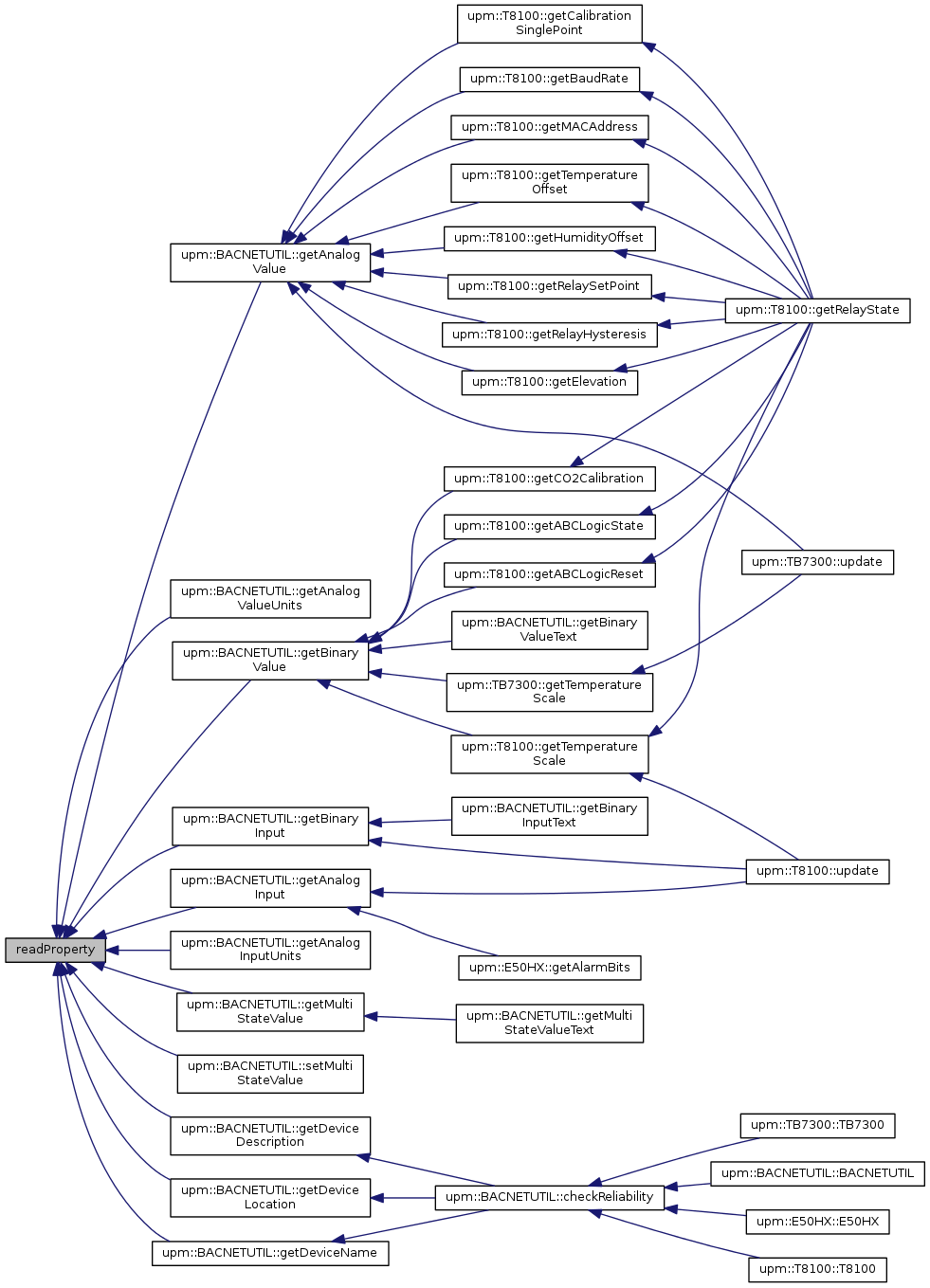
| bool writeProperty | ( | uint32_t | targetDeviceInstanceID, |
| BACNET_OBJECT_TYPE | objType, | ||
| uint32_t | objInstance, | ||
| BACNET_PROPERTY_ID | objProperty, | ||
| BACNET_APPLICATION_DATA_VALUE * | propValue, | ||
| uint8_t | propPriority = BACNET_NO_PRIORITY, |
||
| int32_t | arrayIndex = BACNET_ARRAY_ALL |
||
| ) |
Perform a BACnet writeProperty transaction. This function will return when either the transaction has completed, or an error has occurred. It writes the supplied value to a property, belonging to a specific object instance on a specific device.
| targetDeviceInstanceID | This is the Device Object Instance ID of the device to send the request to. This number will be unique for every device on the network. An address lookup will be performed the first time a request is made to a device using the WhoHas BACnet service. The result will be cached for further use. |
| objType | This is the BACnet object type of the object you wish to query. It should be one of the BACNET_OBJECT_TYPE values. |
| objInstance | This is the instance number of the Object you wish to access. It is an integer starting from 1. |
| objProperty | This is the property of the Object and instance you wish to access. It should be one of the BACNET_PROPERTY_ID values. |
| propValue | This is a pointer to a BACNET_APPLICATION_DATA_VALUE structure containg the data value to write to the property. Use the createData*() methods to properly create these structures. |
| propPriority | This specifies the priority of a commandable property. Leave it at the default unless you know what you are doing. In addition, there is conflicting information in the bacnet-stack documentation as to whether this is even supported. |
| arrayIndex | This specifies the index number of an array property. The default is BACNET_ARRAY_ALL. |
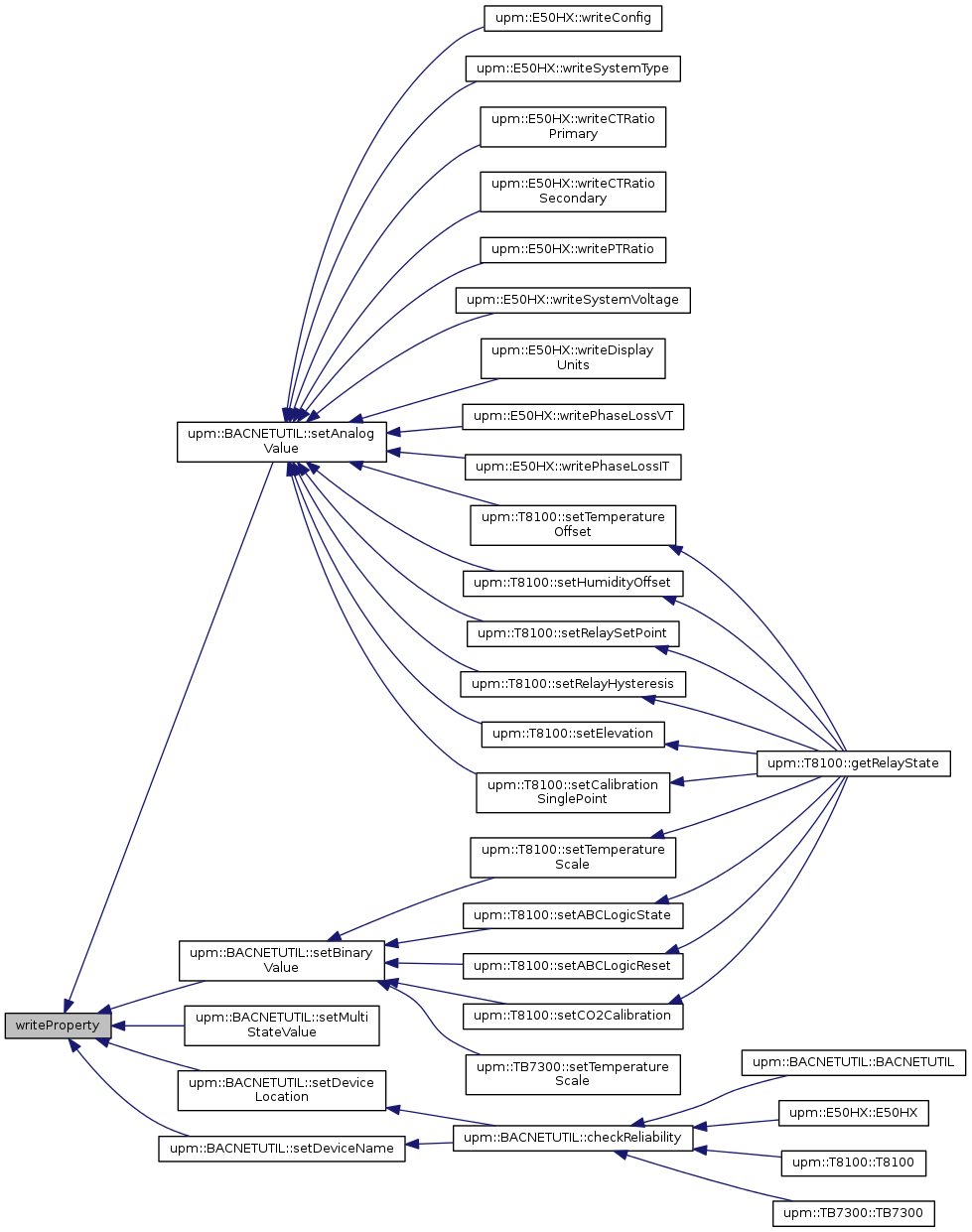
| BACNET_APPLICATION_DATA_VALUE getData | ( | int | index = 0 | ) |
After a successful readProperty request, this method can be used to return a BACNET_APPLICATION_DATA_VALUE structure containing the returned data.
| index | into the list of returned data. 0 (first) is the default. |
| int getDataNumElements | ( | ) |
After a successful readProperty request, this method can be used to return the number of data elements returned. This will usually be 1, unless reading an array.

| uint8_t getDataType | ( | int | index = 0 | ) |
After a successful readProperty request, this method can be used to return the BACnet data type of the returned data. It will be one of the BACNET_APPLICATION_TAG_* values.
| index | into the list of returned data. 0 (first) is the default. |
| float getDataTypeReal | ( | int | index = 0 | ) |
After a successful readProperty request, this method can be used to return the BACnet dataype of the returned data as a Real. If the data type (getDataType()) is not a BACNET_APPLICATION_TAG_REAL, and the value returned cannot be safely converted, an exception is thrown.
| index | into the list of returned data. 0 (first) is the default. |
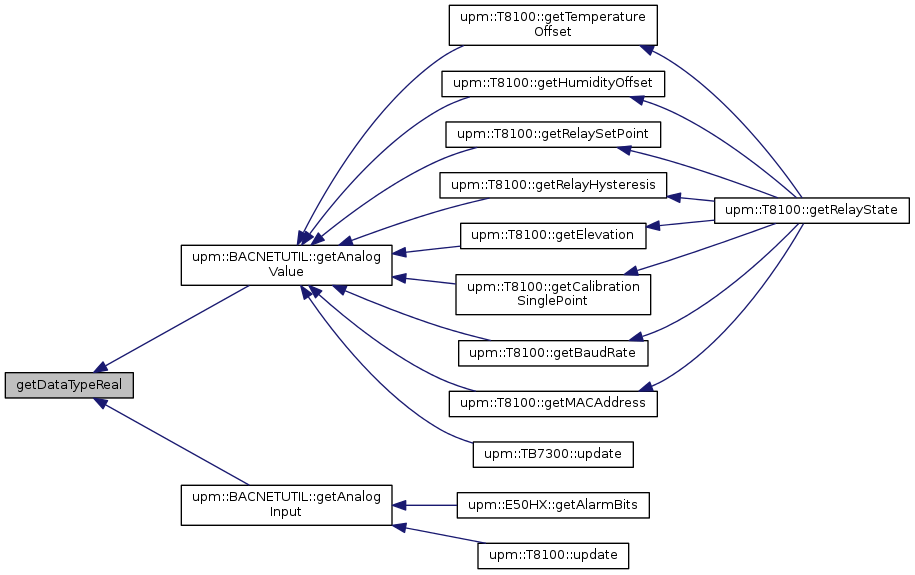
| bool getDataTypeBoolean | ( | int | index = 0 | ) |
After a successful readProperty request, this method can be used to return the BACnet dataype of the returned data as a Boolean. If the data type (getDataType()) is not a BACNET_APPLICATION_TAG_BOOLEAN, and the value returned cannot be safely converted, an exception is thrown.
| index | into the list of returned data. 0 (first) is the default. |
| unsigned int getDataTypeUnsignedInt | ( | int | index = 0 | ) |
After a successful readProperty request, this method can be used to return the BACnet dataype of the returned data as a unsigned int. If the data type (getDataType()) is not a BACNET_APPLICATION_TAG_UNSIGNED_INT, and the value returned cannot be safely converted, an exception is thrown.
| index | into the list of returned data. 0 (first) is the default. |

| int getDataTypeSignedInt | ( | int | index = 0 | ) |
After a successful readProperty request, this method can be used to return the BACnet dataype of the returned data as a signed int. If the data type (getDataType()) is not a BACNET_APPLICATION_TAG_SIGNED_INT, and the value returned cannot be safely converted, an exception is thrown.
| index | into the list of returned data. 0 (first) is the default. |
| string getDataTypeString | ( | int | index = 0 | ) |
After a successful readProperty request, this method can be used to return the BACnet dataype of the returned data as a string. Most of the data types except Enum can be converted to a string. If the data type (getDataType()) is not a BACNET_APPLICATION_TAG_CHARACTER_STRING, and the value returned cannot be safely converted, an exception is thrown.
| index | into the list of returned data. 0 (first) is the default. |

| unsigned int getDataTypeEnum | ( | int | index = 0 | ) |
After a successful readProperty request, this method can be used to return the BACnet dataype of the returned data as an enumeration. If the data type (getDataType()) is not a BACNET_APPLICATION_TAG_ENUMERATED an exception is thrown.
| index | into the list of returned data. 0 (first) is the default. |
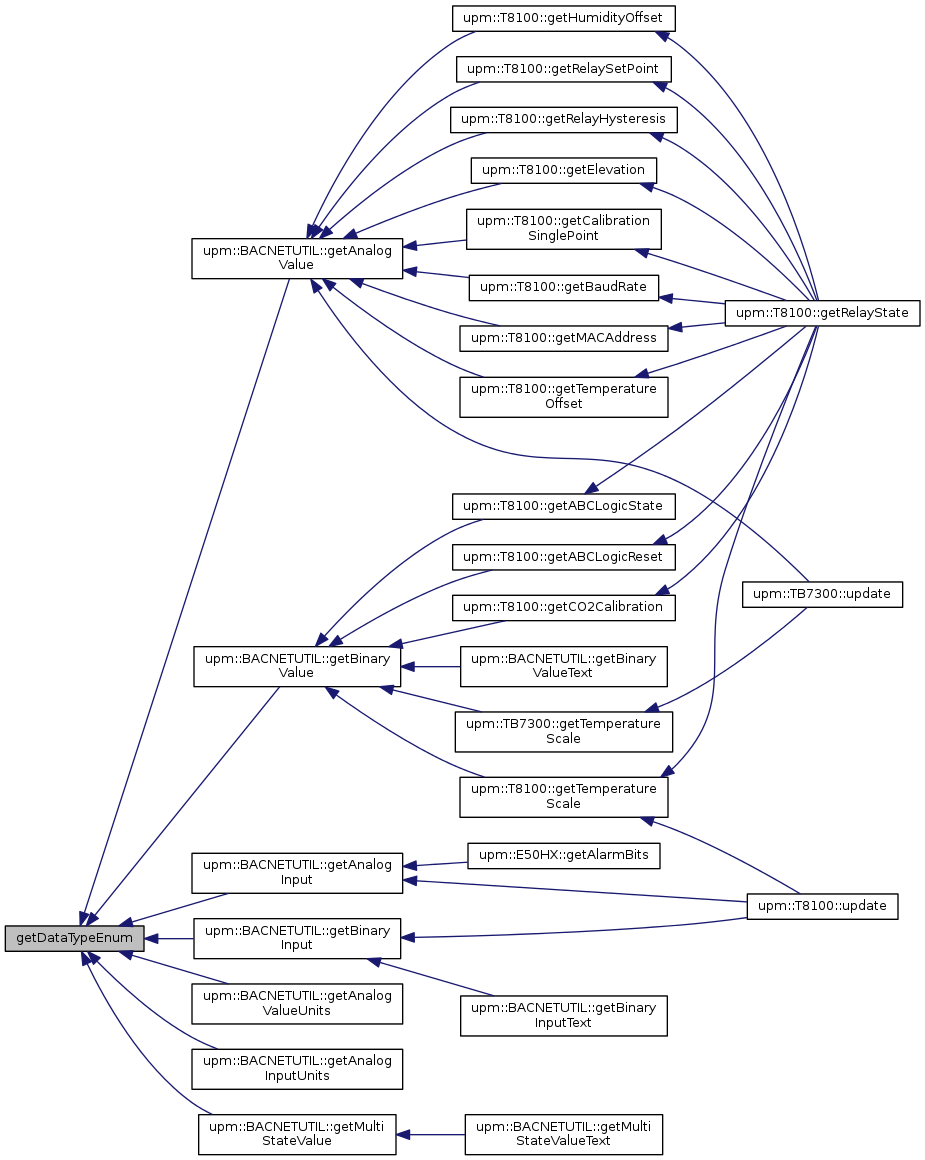
| BACNET_APPLICATION_DATA_VALUE createDataReal | ( | float | Real | ) |
This method is used to create and return an initialized BACNET_APPLICATION_DATA_VALUE containing a real (floating point value). A pointer to this returned structure can then be used with writeProperty().
| value | The floating point value to initialize the structure to. |
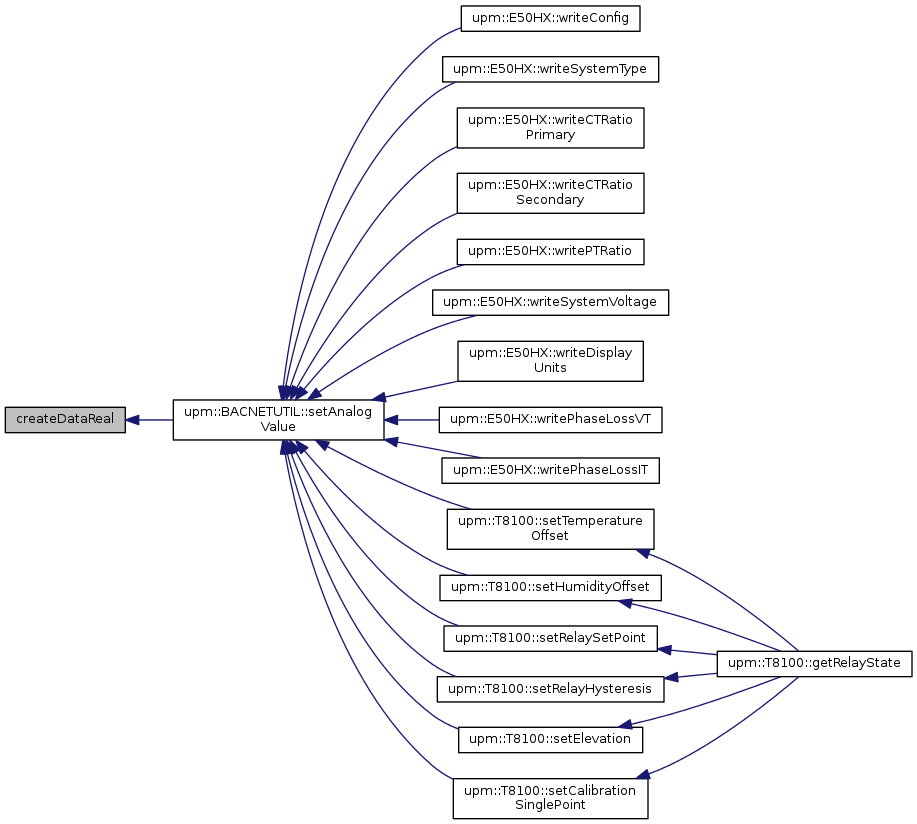
| BACNET_APPLICATION_DATA_VALUE createDataBool | ( | bool | value | ) |
This method is used to create and return an initialized BACNET_APPLICATION_DATA_VALUE containing a boolean. A pointer to this returned structure can then be used with writeProperty().
| value | The boolean value to initialize the structure to. |
| BACNET_APPLICATION_DATA_VALUE createDataSignedInt | ( | int | value | ) |
This method is used to create and return an initialized BACNET_APPLICATION_DATA_VALUE containing a signed integer. A pointer to this returned structure can then be used with writeProperty().
| value | The signed integer value to initialize the structure to. |
| BACNET_APPLICATION_DATA_VALUE createDataUnsignedInt | ( | unsigned int | value | ) |
This method is used to create and return an initialized BACNET_APPLICATION_DATA_VALUE containing a unsigned integer. A pointer to this returned structure can then be used with writeProperty().
| value | The unsigned integer value to initialize the structure to. |

| BACNET_APPLICATION_DATA_VALUE createDataString | ( | std::string | value | ) |
This method is used to create and return an initialized BACNET_APPLICATION_DATA_VALUE containing a character string. A pointer to this returned structure can then be used with writeProperty(). Strings are typically limited to 63 characters.
| value | The character string value to initialize the structure to. |

| BACNET_APPLICATION_DATA_VALUE createDataEnum | ( | uint32_t | value | ) |
This method is used to create and return an initialized BACNET_APPLICATION_DATA_VALUE containing an enumeration. A pointer to this returned structure can then be used with writeProperty().
| value | The BACnet enumeration to initialize the structure to. |

|
inline |
Return an enumration of the last error type to occur. The value returned will be one of the BACERR_TYPE_T values.
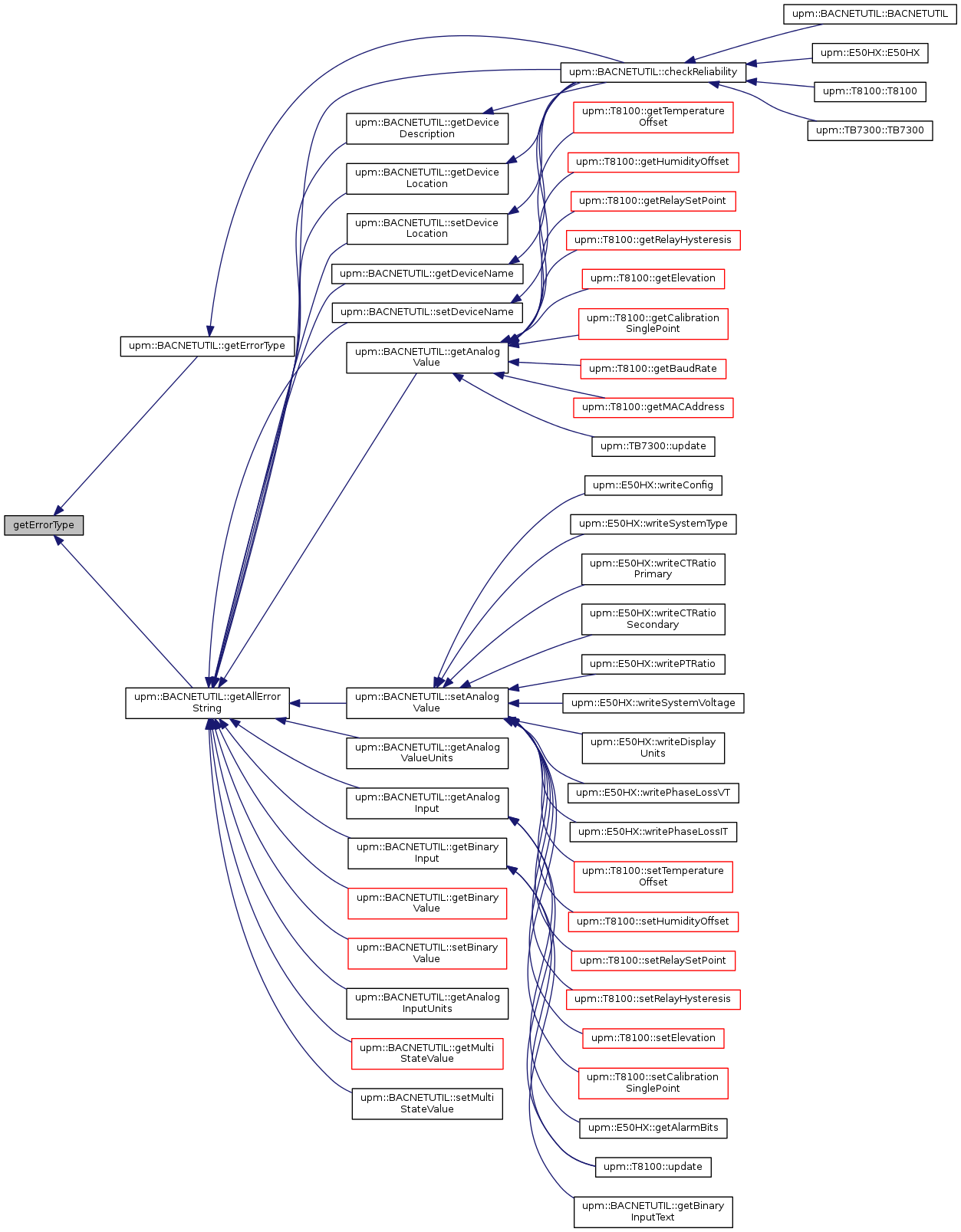
|
inline |
In the event of a BACnet Reject error, return the error code.

|
inline |
In the event of a BACnet Reject error, return the error string.
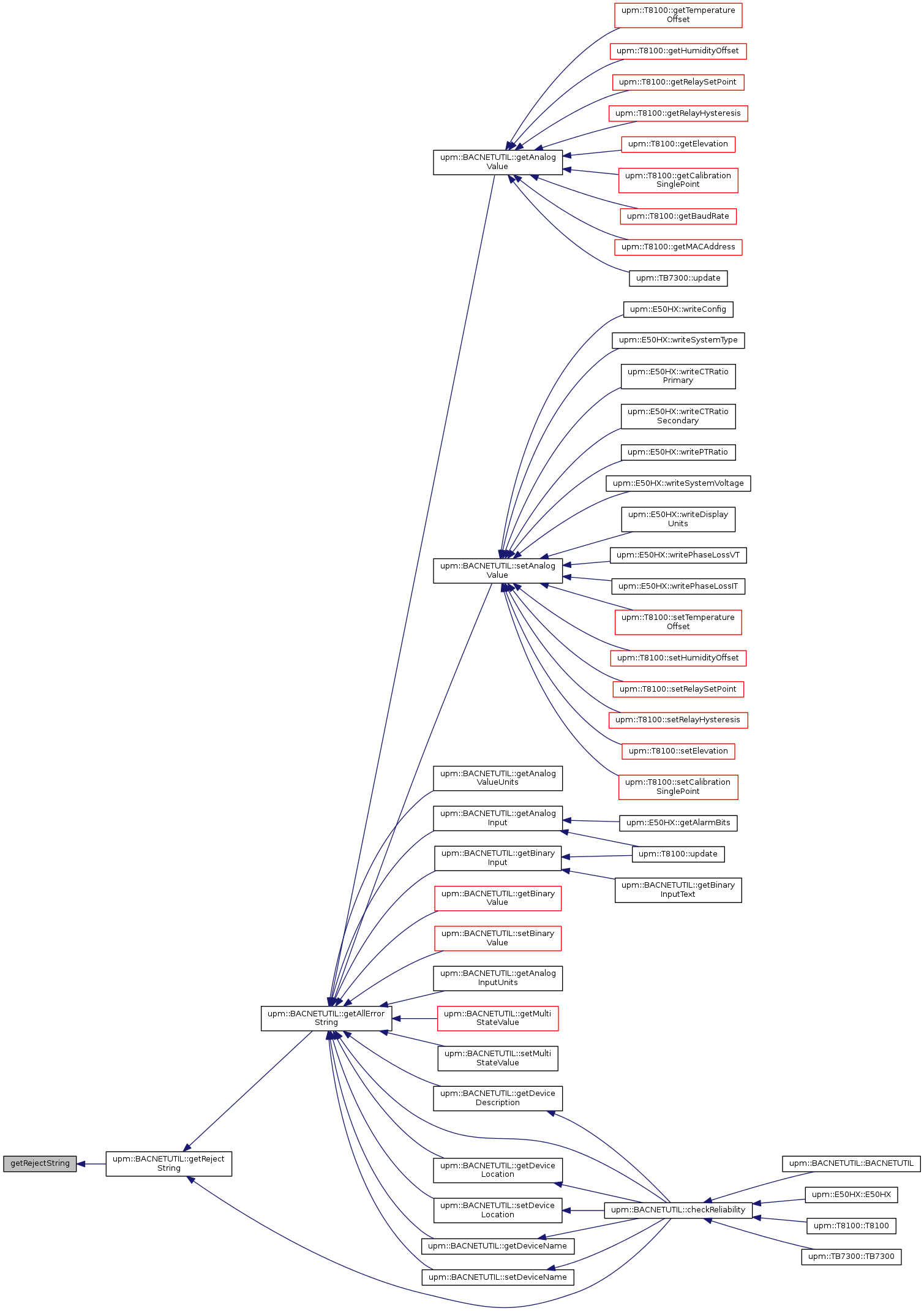
|
inline |
In the event of a BACnet Abort error, return the Abort reason code.

|
inline |
In the event of a BACnet Abort error, return the Abort string.
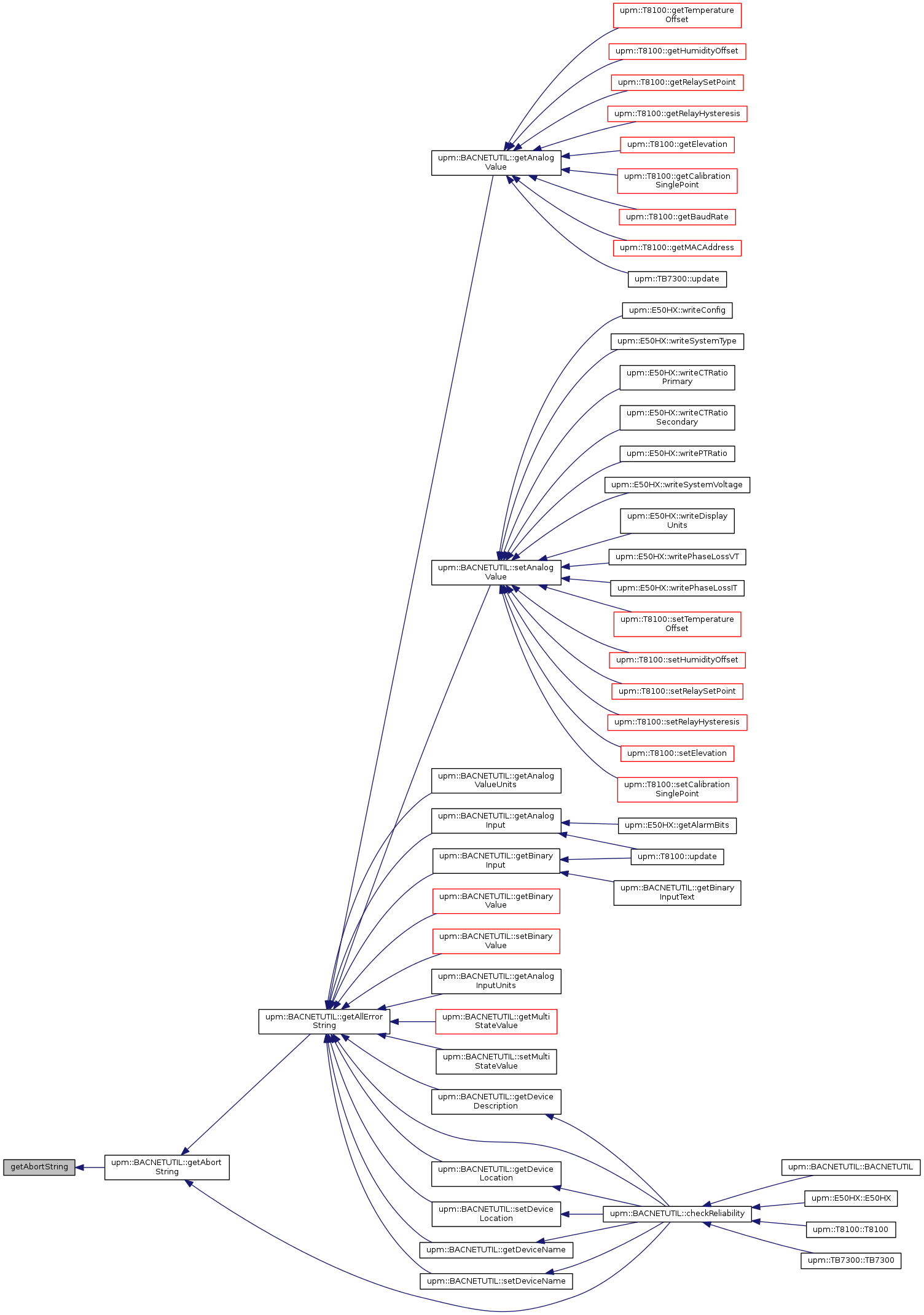
|
inline |
In the event of a general BACnet error, return the BACnet error class.

|
inline |
In the event of a general BACnet error, return the BACnet error code.

|
inline |
In the event of a general BACnet error, return the BACnet error string.
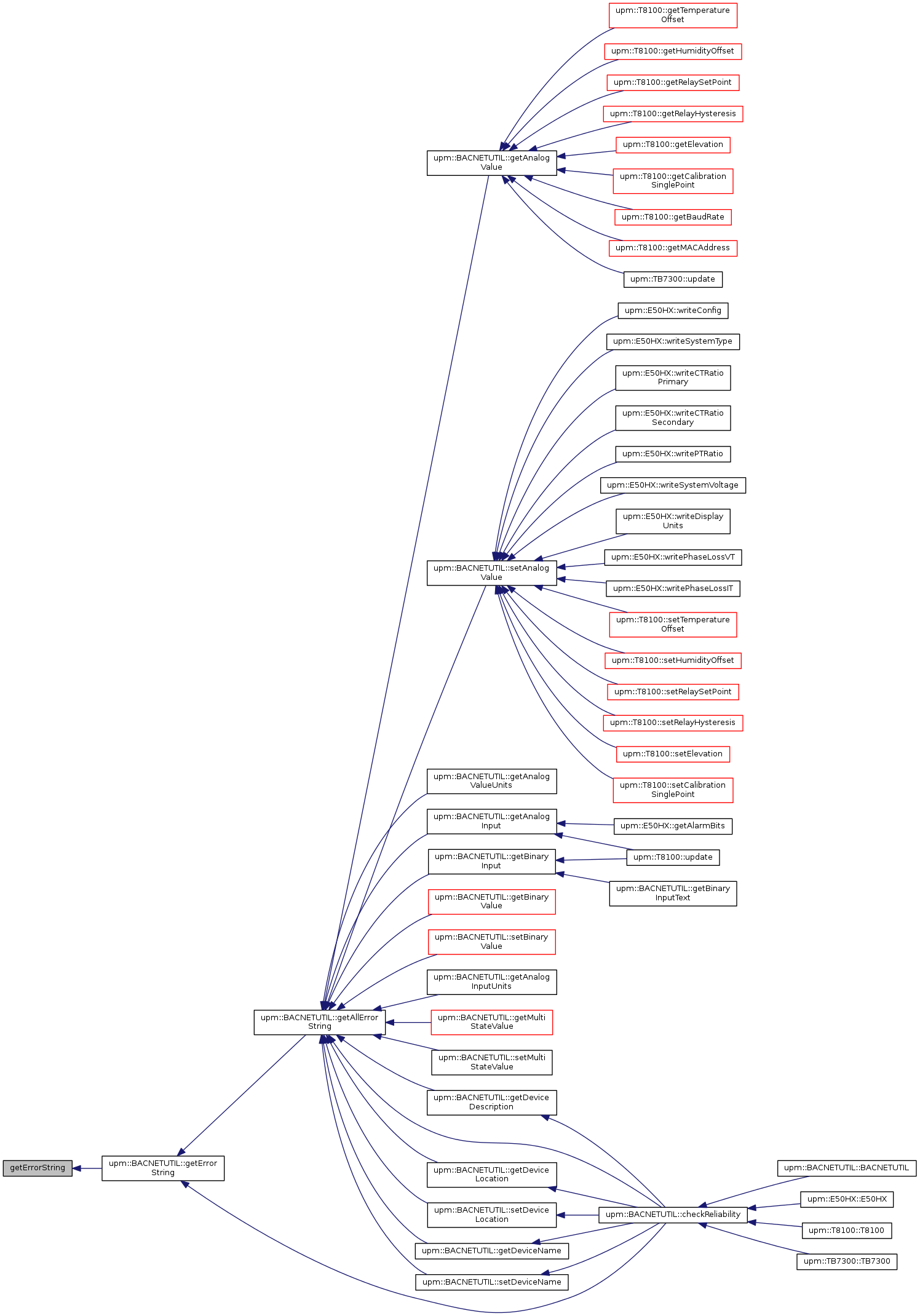
|
inline |
In the event of a non-BACnet UPM error, return a string describing the error.
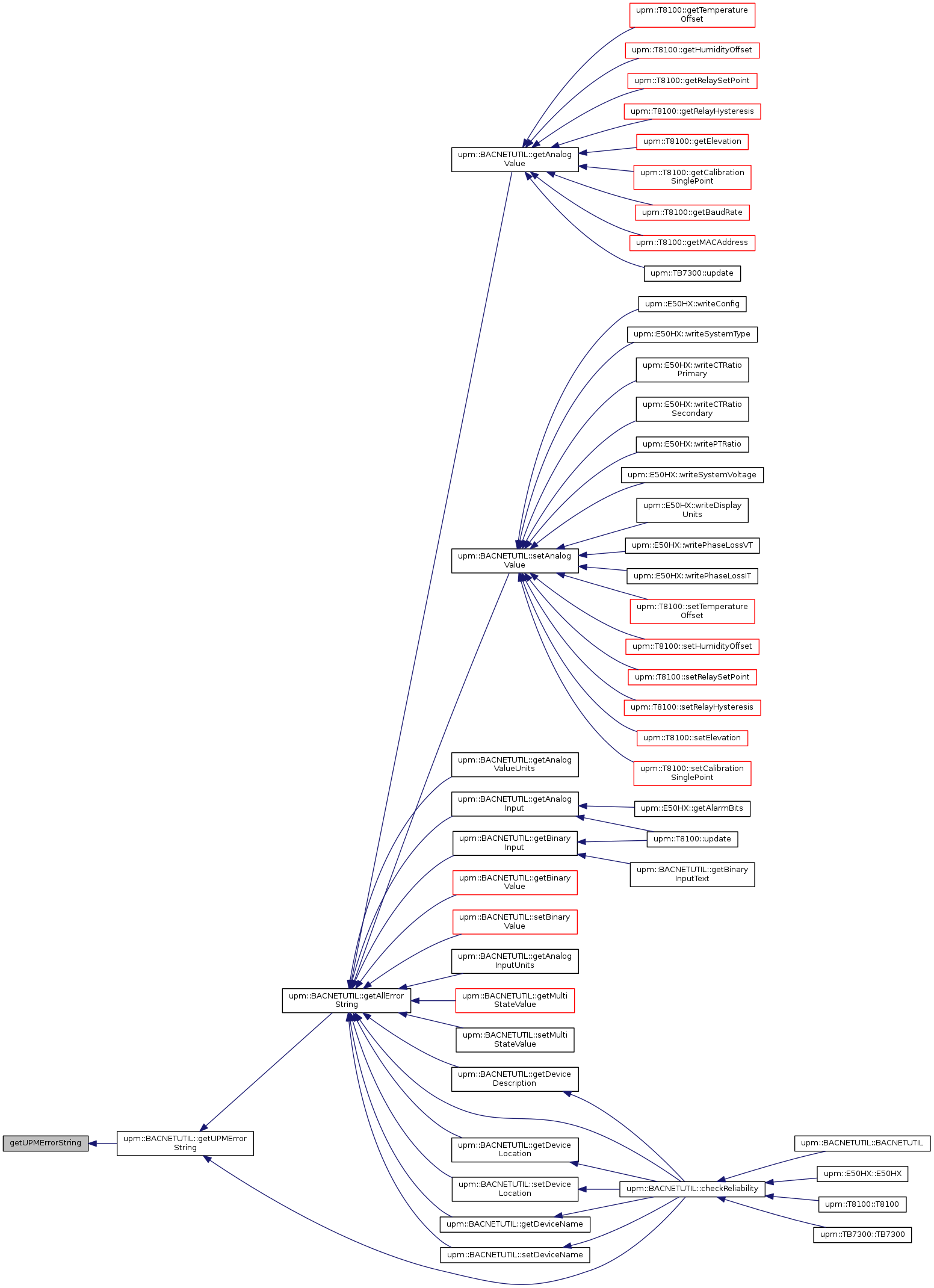
|
inline |
Check to see if initMaster) has already been called, and out master is initialized.

|
inline |
Return the port that was specified to initMaster().
|
inline |
Return the Object Device Instance ID for our Master was specified to initMaster().
|
inline |
Return the maxInfoFrames parameter that was specified to initMaster().
|
inline |
Return the maxMaster parameter that was specified to initMaster().
|
inline |
Return the baud rate parameter that was specified to initMaster().
|
inline |
Return the MAC address parameter that was specified to initMaster().

| void setDebug | ( | bool | enable | ) |
Enable or disable debugging output.
| enable | true to enable debugging, false otherwise |



 1.8.11
1.8.11